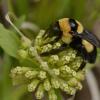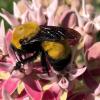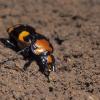Pyractomena ecostata

An adult male keel-necked firefly from Florida. (Photo: Oliver Keller.)
U.S. State
Alabama
Delaware
Florida
New Jersey
Life History
Activity Period and Flash Signal
Depending on the location, adults can be active from April through September. Males emit bright, yellow, explosive courtship signals, about a second in duration, every 8 seconds or so.
Distribution
This firefly has a disjunct distribution, with populations in Alabama, Florida, Delaware, and New Jersey.
Habitat Associations
The keel-necked firefly is a habitat specialist associated with brackish tidal marshes and wet pastures.
Conservation Status
- IUCN Red List status: Endangered
- NatureServe status: G3—Vulnerable, SNR—State Not Ranked (Alabama, Delaware, Florida, New Jersey)
- U.S. Endangered Species Act status: Not listed
Threats
Habitat loss and degradation due to sea level rise, development, the spread of invasive plants, and artificial light at night are the main threats to this species.
Conservation Needs
- We need to know more about the distribution of this species. Please check out the Firefly Atlas to help us track and conserve this threatened firefly.
- Turn off your outdoor lights at night so the lights of this firefly aren’t diminished by light pollution. You can read more about firefly-friendly lighting in our fact sheet.
- Avoid pesticide use, which could harm this firefly, its habitat, or its prey.
- More research on population size and trend, habitats and ecology, and threats is needed for this species.
Prepared By
Candace Fallon, The Xerces Society for Invertebrate Conservation, based on the IUCN Red List assessment
USA





